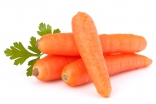Content Tagged with Nutrition Centre
Gajar (carrot) is a crunchy root vegetable available in a range of colours like orange, red, yellow, purple and white. It is a good source of beta carotene, which is converted to vitamin A in our bodies.
Feeri (blueberries) are found naturally in the cooler climates of North America and Europe. Ripe feeri have a deep blue thin skin, with a green fleshy middle and a sweet taste.
Elaichi is a spice used in Arabic, South Asian and even Chinese traditions to add a sweet aromatic flavour to desserts, chai, curries and rice dishes. In both Ayruvedic and traditional Chinese medicine, it has been used to treat digestion and oral health issues.
Daraam is a fruit with a reddish, leathery outer skin that houses edible seeds that are divided by white membranes. It is thought to be beneficial to your health.
Chuqander are usually a deep red colour but there are varieties ranging from white, orange and even striped. Both the beets and their greens can be eaten as they are tasty and full of unique nutritious properties.
You may have memories of your grandma telling you to eat “saath (seven) badaam a day.” Well, as explained in this latest Nutrition Centre A to Z article, research suggests that she was giving you good advice!
The Ismaili Nutrition Centre has launched a new series of articles on simple ideas for popular foods. This A to Z of different fruits, vegetables and everyday ingredients builds greater awareness of basic nutrition and encourages you to try healthy and easy ideas for preparing a range of tasty dishes. This week's entry is about amla, a tangy seasonal fruit that is high in vitamin C.
High in vegetables, whole grains, beans, nuts, fruit, and fish, the Mediterranean diet is associated with a significant improvement in quality of life. Many South Asian foods work well with it, and some simple changes can help you incorporate the Mediterranean lifestyle into your daily living.
Over 50 per cent of people with pre-diabetes who eat healthier and are physically active can delay or even entirely prevent themselves from becoming diabetic. For those who have type 2 diabetes, eating cooked pulses along with a high-fibre diet can help control long term blood sugar levels.
In 2008, non-communicable diseases were responsible for an astounding 63 per cent of deaths world-wide – more than all other causes combined. Known as NCDs, they include diabetes, heart disease and cancers, and are a growing concern to people of South East Asian descent. However, these diseases are largely preventable and their impact can be significantly reduced.
Childhood obesity rates in the United States have more than tripled in the past thirty years, with many other western countries showing similar trends. What foods are children eating that may be contributing to this epidemic, and what can be done? Researchers at the US National Cancer Institute used the national nutrition survey database to find answers.
Eating too much sodium and not enough potassium has been shown to increase blood pressure, which can be dangerous because it makes the heart work harder than normal and can lead to heart disease or stroke. Recently, the World Health Organization (WHO) issued new recommendations on how much sodium, salt and potassium people should eat for good health.
Small lifestyle changes are easier to sustain and are more likely to last. Making a drastic change is difficult and less likely to be successful. Rather than focusing on immediate results, it is better to take things one step at a time and not to become discouraged.
The start of a new year is a great time to make improvements to your lifestyle habits, whether by being more active or cooking more healthily. Setting SMART goals is an effective approach that can be used not only for health, but also in other aspects of life.
The feeling of fullness is very difficult to measure, or even to understand, as there are many factors involved. Although some people believe that all calories are equal, researchers are finding that solid foods have some advantages over fluids.
When talented, well-trained and enthusiastic athletes meet in competition, attention to detail can make all the difference between defeat and victory. What you eat and drink affects how well you train and whether you can compete at your best. Registered dietitian and sports nutritionist Linia Patel shares some tips.
Eating out at an Indian or Pakistani restaurant can be nutritious; however, it is less healthy when food items are deep-fried, cooked in excess oil, or prepared in ghee, coconut oil or coconut milk. Here are some tips for making healthier choices.
Few children are born with a liking for every vegetable, but researchers wondered if infants could learn to enjoy a specific vegetable, and how many tastes it would take. Their studies show that while it may take more than 10 attempts to get the child to try something new, with encouragement children can get used to flavours, textures and consistency of food.
How many times do we receive emails claiming that a specific combination of foods will cure cancer, or that eating large amounts of certain foods will eliminate our cholesterol? Nutrition advice is everywhere, but it is important to know how to separate credible, good nutrition information from the rest.
In the second part of her article on managing cholesterol, Baldeesh Rai, Dietetic Advisor to Heart UK adds to her recommendations on fats and sugar. She discusses the importance of eating more fibre and being active.























